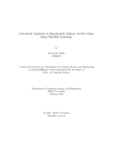| dc.contributor.advisor | Alam, Md. Golam Rabiul | |
| dc.contributor.author | Hasib, Khan Md. | |
| dc.date.accessioned | 2022-05-25T03:46:04Z | |
| dc.date.available | 2022-05-25T03:46:04Z | |
| dc.date.copyright | 2022 | |
| dc.date.issued | 2022-02 | |
| dc.identifier.other | ID 20266015 | |
| dc.identifier.uri | http://hdl.handle.net/10361/16666 | |
| dc.description | This thesis is submitted in partial fulfillment of the requirements for the degree of Master of Science in Computer Science and Engineering, 2022. | en_US |
| dc.description | Cataloged from PDF version of thesis. | |
| dc.description | Includes bibliographical references (pages 66-73). | |
| dc.description.abstract | A common means of transportation in our everyday lives is air travel. As a result, it's
no surprise that more and more customers are posting their airline reviews online.
However, in the age of machine learning, it would be much easier to extract millions
of pieces of information and knowledge from them if a model was used to polarize
and comprehend them. Sentiment analysis may be used to understand people's
attitudes or sentiments by utilizing sites that provide opinion-rich data. In this work,
we worked on a customized dataset including online reviews for 4 major Bangladesh
Airlines, performed a multiclass sentiment analysis, and compared the classi ers.
Alongside sentiment analysis, topic modeling is also done to get better decisions
based on the actual experiences of other customers who have
own with airlines.
This method begins with pre-processing procedures used to clean the reviews and
balance the review data using the Pegasus model's oversampling mechanism. The
analysis was carried out 3 di erent machine learning (Decision Tree, Random Forest,
and XGBoost) and 3 di erent deep learning classi cation strategies (CNN, LSTM,
BERT). The test set's output is the review sentiment (positive/negative/mixed)
using a three-class dataset, and the performance in terms of accuracy is calculated.
Based on the results, we have achieved the best accuracy 83% in terms of BERT.
The accuracies were determined to compare each categorization technique, and the
total sentiment count for all four airlines of Bangladesh was displayed in terms of
domestic route, international route and overall route. We comprehend the results
acquired from USA airlines Tweets data and demonstrate that our framework is
more e cient than the earlier model. Therefore, it is essential to consider whether
a sentiment makes a particular prediction. Thus, we then train an interpretable
LIME model for the sentiments and the construction of explainable sentiments can
have a major advantage. | en_US |
| dc.description.statementofresponsibility | Khan Md. Hasib | |
| dc.format.extent | 73 pages | |
| dc.language.iso | en | en_US |
| dc.publisher | Brac University | en_US |
| dc.rights | Brac University theses are protected by copyright. They may be viewed from this source for any purpose, but reproduction or distribution in any format is prohibited without written permission. | |
| dc.subject | Bangladesh Airlines | en_US |
| dc.subject | Online review | en_US |
| dc.subject | Sentiment analysis | en_US |
| dc.subject | Topic modeling | en_US |
| dc.subject | Deep learning | en_US |
| dc.subject | LIME | en_US |
| dc.subject.lcsh | Machine learning | |
| dc.subject.lcsh | Cognitive learning theory (Deep learning) | |
| dc.title | Sentiment analysis on Bangladesh airlines review data using machine learning | en_US |
| dc.type | Thesis | en_US |
| dc.contributor.department | Department of Computer Science and Engineering, Brac University | |
| dc.description.degree | M. Computer Science and Engineering | |

